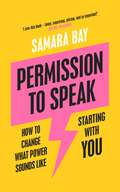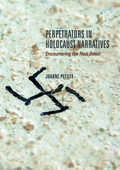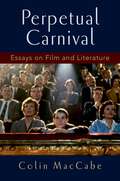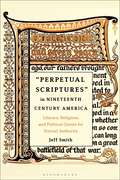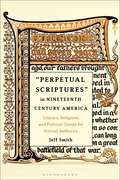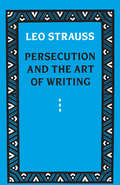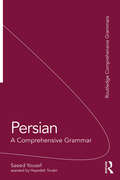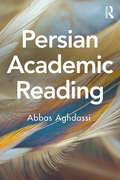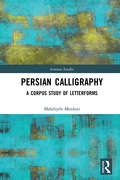- Table View
- List View
Permanently Online, Permanently Connected: Living and Communicating in a POPC World
by Peter Vorderer Dorothée Hefner Leonard Reinecke Christoph KlimmtPermanently Online, Permanently Connected establishes the conceptual grounds needed for a solid understanding of the permanently online/permanently connected phenomenon, its causes and consequences, and its applied implications. Due to the diffusion of mobile devices, the ways people communicate and interact with each other and use electronic media have changed substantially within a short period of time. This megatrend comes with fundamental challenges to communication, both theoretical and empirical. The book offers a compendium of perspectives and theoretical approaches from leading thinkers in the field to empower communication scholars to develop this research systematically, exhaustively, and quickly. It is essential reading for media and communication scholars and students studying new media, media effects, and communication theory.
Permission to Speak: How to Change What Power Sounds Like, Starting With You
by Samara Bay'I love this book - funny, surprising, stirring, and so important!' - Rachel McAdams*****WHAT DOES POWER SOUND LIKE? LOUD? BRASH? MASCULINE?Here's the truth: if you're a woman, a person of colour, an immigrant or queer, there's often dissonance between how you speak and how we think powerful people sound, i.e. the wealthy white men who have historically set the standard.WELL, IT'S TIME FOR THAT TO CHANGE!In this witty and warm guide, speech expert Samara Bay, who has worked with the likes of Gal Gadot, Penélope Cruz and Terry Crews, as well as global leaders in business and politics, offers a new approach to asserting your power in all areas of life. Permission to Speak is packed with expert tips and easy-to-follow exercises, as well as anecdotes and eye-opening research on the fundamentals of breath and the musicality of storytelling.Demonstrating that you don't have to speak like the status quo to be taken seriously, Bay explodes what we think our voices should sound like to get to the very heart of what they can be.
Perpetrators in Holocaust Narratives: Encountering the Nazi Beast
by Joanne PettittThis study provides a comprehensive analysis of representations of Holocaust perpetrators in literature. Such texts, often rather controversially, seek to undo the myth of pure evil that surrounds the Holocaust and to reconstruct the perpetrator in more human (“banal”) terms. Following this line of thought, protagonists frequently place emphasis on the contextual or situational factors that led up to the genocide. A significant consequence of this is the impact that it has on the reader, who is thereby drawn into the narrative as a potential perpetrator who could, in similar circumstances, have acted in similar ways. The tensions that this creates, especially in relation to the construction of empathy, constitutes a major focus of this work. Making use of in excess of sixty primary sources, this work explores fictional accounts of Holocaust perpetration as well as Nazi memoirs. It will be of interest to anyone working in the broad areas of Holocaust literature and/or perpetrator studies.
Perpetrators in Holocaust Narratives: Encountering the Nazi Beast
by Joanne PettittThis study provides a comprehensive analysis of representations of Holocaust perpetrators in literature. Such texts, often rather controversially, seek to undo the myth of pure evil that surrounds the Holocaust and to reconstruct the perpetrator in more human (“banal”) terms. Following this line of thought, protagonists frequently place emphasis on the contextual or situational factors that led up to the genocide. A significant consequence of this is the impact that it has on the reader, who is thereby drawn into the narrative as a potential perpetrator who could, in similar circumstances, have acted in similar ways. The tensions that this creates, especially in relation to the construction of empathy, constitutes a major focus of this work. Making use of in excess of sixty primary sources, this work explores fictional accounts of Holocaust perpetration as well as Nazi memoirs. It will be of interest to anyone working in the broad areas of Holocaust literature and/or perpetrator studies.
Perpetual Carnival: Essays on Film and Literature
by Colin MacCabeUpholding literature and film together as academically interwoven, Perpetual Carnival underscores the everlasting coexistence of realism and modernism, eschewing the popularly accepted view that the latter is itself a rejection of the former. Mining examples from both film and literature, Colin MacCabe asserts that the relationship between film and literature springs to life a wealth of beloved modernist art, from Jean-Luc Godard's Pierre le Fou to James Joyce's Ulysses, enriched by realism's enduring legacy. The intertextuality inherent in adaptation furthers this assertion in MacCabe's inclusion of Roman Polanski's Tess, a 1979 adaptation of Thomas Hardy's nineteenth-century realist novel, Tess of the d'Urbervilles. Showcasing essays enlivened by cosmopolitan interests, theoretical insight, and strong social purpose, Perpetual Carnival supports a humanities which repudiates narrow specialization and which seeks to place the discussion of film and literature firmly in the reality of current political and ideological discussion. It argues for the writers and directors, the thinkers and critics, who have most fired the contemporary imagination.
Perpetual Carnival: Essays on Film and Literature
by Colin MacCabeUpholding literature and film together as academically interwoven, Perpetual Carnival underscores the everlasting coexistence of realism and modernism, eschewing the popularly accepted view that the latter is itself a rejection of the former. Mining examples from both film and literature, Colin MacCabe asserts that the relationship between film and literature springs to life a wealth of beloved modernist art, from Jean-Luc Godard's Pierre le Fou to James Joyce's Ulysses, enriched by realism's enduring legacy. The intertextuality inherent in adaptation furthers this assertion in MacCabe's inclusion of Roman Polanski's Tess, a 1979 adaptation of Thomas Hardy's nineteenth-century realist novel, Tess of the d'Urbervilles. Showcasing essays enlivened by cosmopolitan interests, theoretical insight, and strong social purpose, Perpetual Carnival supports a humanities which repudiates narrow specialization and which seeks to place the discussion of film and literature firmly in the reality of current political and ideological discussion. It argues for the writers and directors, the thinkers and critics, who have most fired the contemporary imagination.
Perpetual Scriptures in Nineteenth-Century America: Literary, Religious, and Political Quests for Textual Authority
by Jeff SmithIn the tumultuous decades of rapid expansion and change between the American Founding and the Civil War, Americans confronted a cluster of overlapping crises whose common theme was the difficulty of finding authority in written texts. The issue arose from several disruptive developments: rising challenges to the traditional authority of the Bible in a society that was intensely Protestant; persistent worries over America's lack of a “national literature” and an independent cultural identity; and the slavery crisis, which provoked tremendous struggles over clashing interpretations of the Declaration of Independence and the Constitution, even as these “parascriptures” were rising to the status of a kind of quasi-sacred secular canon. At the same time but from the opposite direction, new mass media were creating a new, industrial-scale print culture that put a premium on very non-sacred, disposable text: mass-produced “news,” dispensed immediately and in huge quantities but meant only for the day or hour. Perpetual Scriptures in Nineteenth-Century America identifies key features of the writings, careers and cultural politics of several prominent Americans as responses to this cluster of challenges. In their varied attempts to vindicate the sacred and to merge the timeless with the urgent present, Joseph Smith, Ralph Waldo Emerson, Margaret Fuller, Theodore Parker, Harriet Beecher Stowe, Walt Whitman, Frederick Douglass, Martin Delany, Abraham Lincoln, and other religious and political leaders and men and women of letters helped define American literary culture as an ongoing quest for new “bibles,” or what Emerson called a “perpetual scripture.”
Perpetual Scriptures in Nineteenth-Century America: Literary, Religious, and Political Quests for Textual Authority
by Jeff SmithIn the tumultuous decades of rapid expansion and change between the American Founding and the Civil War, Americans confronted a cluster of overlapping crises whose common theme was the difficulty of finding authority in written texts. The issue arose from several disruptive developments: rising challenges to the traditional authority of the Bible in a society that was intensely Protestant; persistent worries over America's lack of a “national literature” and an independent cultural identity; and the slavery crisis, which provoked tremendous struggles over clashing interpretations of the Declaration of Independence and the Constitution, even as these “parascriptures” were rising to the status of a kind of quasi-sacred secular canon. At the same time but from the opposite direction, new mass media were creating a new, industrial-scale print culture that put a premium on very non-sacred, disposable text: mass-produced “news,” dispensed immediately and in huge quantities but meant only for the day or hour. Perpetual Scriptures in Nineteenth-Century America identifies key features of the writings, careers and cultural politics of several prominent Americans as responses to this cluster of challenges. In their varied attempts to vindicate the sacred and to merge the timeless with the urgent present, Joseph Smith, Ralph Waldo Emerson, Margaret Fuller, Theodore Parker, Harriet Beecher Stowe, Walt Whitman, Frederick Douglass, Martin Delany, Abraham Lincoln, and other religious and political leaders and men and women of letters helped define American literary culture as an ongoing quest for new “bibles,” or what Emerson called a “perpetual scripture.”
The Perraults: A Family of Letters in Early Modern France
by Oded RabinovitchIn The Perraults, Oded Rabinovitch takes the fascinating eponymous literary and scientific family as an entry point into the complex and rapidly changing world of early modern France. Today, the Perraults are best remembered for their canonical fairy tales, such as "Cinderella" and "Puss in Boots," most often attributed to Charles Perrault, one of the brothers. While the writing of fairy tales may seem a frivolous enterprise, it was, in fact, linked to the cultural revolution of the seventeenth century, which paved the way for the scientific revolution, the rise of "national literatures," and the early Enlightenment. Rabinovitch argues that kinship networks played a crucial, yet unexamined, role in shaping the cultural and intellectual ferment of the day, which in turn shaped kinship and the social history of the family.Through skillful reconstruction of the Perraults’ careers and networks, Rabinovitch portrays the world of letters as a means of social mobility. He complicates our understanding of prominent institutions, such as the Academy of Sciences, Versailles, and the salons, as well as the very notions of authorship and court capitalism. The Perraults shows us that institutions were not simply rigid entities, embodying or defining intellectual or literary styles such as Cartesianism, empiricism, or the purity of the French language. Rather, they emerge as nodes that connect actors, intellectual projects, family strategies, and practices of writing.
»Perry Rhodan« lesen: Zur Serialität der Lektürepraktiken einer Heftromanserie (Lettre)
by Mirjam NastWelche Bedeutung hat Serialität für den Lektüreprozess? Anhand der Heftromanserie »Perry Rhodan« untersucht Mirjam Nast ein breites Spektrum von Lektürepraktiken: Basierend auf einem Spiralmodell des Serienlesens berücksichtigt sie auch zurückliegende Serienerfahrungen und arbeitet Lektüremodi heraus, die sich über längere Zeit des Serienlesens entwickelt haben. Im Anschluss an die Akteur-Netzwerk-Theorie versteht die Studie Lesen als ein Zusammenspiel unterschiedlicher Akteure, zu denen neben den Leser_innen auch die Serie mit ihren materiellen und ästhetischen Aspekten gehört.
Persecution and Morality: Intersections and Tensions between Freud and Lévinas
by Valerie Oved GiovaniniThis book shows how persecution is a condition that binds each in an ethical obligation to the other. Persecution is functionally defined here as an impinging, affective relation that is not mediated by reason. It focuses on the works and personal lives of Emmanuel Lévinas—a phenomenological ethicist who understood persecution as an ontological condition for human existence—and Sigmund Freud, the inventor of psychoanalysis who proposed that a demanding superego is a persecuting psychological mechanism that enables one to sadistically enjoy moral injunctions.Scholarship on the work of Freud and Lévinas remains critical about their objectivity, but this book uses the phenomenological method to bracket this concern with objective truth and instead reconstruct their historical biographies to evaluate their hyperbolically opposing claims. By doing so, it is suggested that moral actions and relations of persecution in their personal lives illuminate the epistemic limits that they argued contribute to the psychological and ontological necessity of persecuting behaviors. Object relations and intersubjective approaches in psychoanalysis successfully incorporate meaningful elements from both of their theoretical works, which is used to develop an intentionality of search that is sensitive to an unknowable, relational, and existentially vulnerable ethical subjectivity.Details from Freud’s and Lévinas’ works and lives, on the proclivity to use persecution to achieve moral ends, provide significant ethical warnings, and the author uses them as a strategy for developing the reader’s intentionality of search, to reflect on when they may use persecuting means for moral ends.The interdisciplinary nature of this research monograph is intended for academics, scholars, and researchers who are interested in psychoanalysis, moral philosophy, and phenomenology. Comparisons between various psychoanalytic frameworks and Lévinas’ ethic will also interest scholars who work on the relation between psychoanalysis and The Other. Lévinas scholars will value the convergences between his ethics and Freud’s moral skepticism; likewise, readers will be interested in the extension of Lévinas’ intentionality of search. The book is useful for undergraduate or graduate courses on literary criticism and critical theories worldwide.
Persecution and the Art of Writing
by Leo StraussThe essays collected in Persecution and the Art of Writing all deal with one problem—the relation between philosophy and politics. Here, Strauss sets forth the thesis that many philosophers, especially political philosophers, have reacted to the threat of persecution by disguising their most controversial and heterodox ideas.
Persecution and the Art of Writing
by Leo StraussThe essays collected in Persecution and the Art of Writing all deal with one problem—the relation between philosophy and politics. Here, Strauss sets forth the thesis that many philosophers, especially political philosophers, have reacted to the threat of persecution by disguising their most controversial and heterodox ideas.
Persecution and the Art of Writing
by Leo StraussThe essays collected in Persecution and the Art of Writing all deal with one problem—the relation between philosophy and politics. Here, Strauss sets forth the thesis that many philosophers, especially political philosophers, have reacted to the threat of persecution by disguising their most controversial and heterodox ideas.
Persecution and the Art of Writing
by Leo StraussThe essays collected in Persecution and the Art of Writing all deal with one problem—the relation between philosophy and politics. Here, Strauss sets forth the thesis that many philosophers, especially political philosophers, have reacted to the threat of persecution by disguising their most controversial and heterodox ideas.
Persecution, Plague, and Fire: Fugitive Histories of the Stage in Early Modern England
by Ellen MacKayThe theater of early modern England was a disastrous affair. The scant record of its performance demonstrates as much, for what we tend to remember today of the Shakespearean stage and its history are landmark moments of dissolution: the burning down of the Globe, the forced closure of playhouses during outbreaks of the plague, and the abolition of the theater by its Cromwellian opponents. Persecution, Plague, and Fire is a study of these catastrophes and the theory of performance they convey. Ellen MacKay argues that the various disasters that afflicted the English theater during its golden age were no accident but the promised end of a practice built on disappearance and erasure—a kind of fatal performance that left nothing behind but its self-effacing poetics. Bringing together dramatic theory, performance studies, and theatrical, religious, and cultural history, MacKay reveals the period’s radical take on the history and the future of the stage to show just how critical the relation was between early modern English theater and its public.
Persecution, Plague, and Fire: Fugitive Histories of the Stage in Early Modern England
by Ellen MacKayThe theater of early modern England was a disastrous affair. The scant record of its performance demonstrates as much, for what we tend to remember today of the Shakespearean stage and its history are landmark moments of dissolution: the burning down of the Globe, the forced closure of playhouses during outbreaks of the plague, and the abolition of the theater by its Cromwellian opponents. Persecution, Plague, and Fire is a study of these catastrophes and the theory of performance they convey. Ellen MacKay argues that the various disasters that afflicted the English theater during its golden age were no accident but the promised end of a practice built on disappearance and erasure—a kind of fatal performance that left nothing behind but its self-effacing poetics. Bringing together dramatic theory, performance studies, and theatrical, religious, and cultural history, MacKay reveals the period’s radical take on the history and the future of the stage to show just how critical the relation was between early modern English theater and its public.
Persephone Rises, 1860–1927: Mythography, Gender, and the Creation of a New Spirituality
by Margot K. LouisOver the course of the nineteenth century, the figure of Persephone rapidly evolved from what was essentially a decorative metaphor into a living goddess who embodied the most spiritual aspects of ancient Greek religion. In the first comprehensive survey of the Persephone myth in English and American literature of the nineteenth and early twentieth centuries, Margot Louis explores the transformation of the goddess to provide not only a basis for understanding how the study of ancient history informed the creation of a new spirituality but for comprehending the deep and bitter tensions surrounding gender that interacted with this process. Beginning with an overview of the most influential ancient texts on Persephone and references to Persephone in Chaucer, Shakespeare, Milton, and Romantic period writing, Louis shows that the earliest theories of matriarchy and patriarchal marriage emerged in the 1860s alongside the first English poems to explore Persephone's story. As scholars began to focus on the chthonic Mystery cults, and particularly on the Eleusinian Mysteries of Demeter and Persephone, poets and novelists explored the divisions between mother and daughter occasioned by patriarchal marriage. Issues of fertility and ritual resonate in Thomas Hardy's Tess of the d'Urbervilles and Willa Cather's My Antonia, while the first advance of a neo-pagan spirituality, as well as early feminist critiques of male mythography and of the Persephone myth, emerge in Modernist poems and fictions from 1908 to 1927. Informed by the latest research and theoretical work on myth, Margot Louis's fascinating study shows the development of Victorian mythography in a new light; offers original takes on Victorian representations of gender and values; exposes how differently male and female Modernists dealt with issues of myth, ritual, and ancient spirituality; and uncovers how deeply the study of ancient spirituality is entwined with controversies about gender.
Persephone Rises, 1860–1927: Mythography, Gender, and the Creation of a New Spirituality
by Margot K. LouisOver the course of the nineteenth century, the figure of Persephone rapidly evolved from what was essentially a decorative metaphor into a living goddess who embodied the most spiritual aspects of ancient Greek religion. In the first comprehensive survey of the Persephone myth in English and American literature of the nineteenth and early twentieth centuries, Margot Louis explores the transformation of the goddess to provide not only a basis for understanding how the study of ancient history informed the creation of a new spirituality but for comprehending the deep and bitter tensions surrounding gender that interacted with this process. Beginning with an overview of the most influential ancient texts on Persephone and references to Persephone in Chaucer, Shakespeare, Milton, and Romantic period writing, Louis shows that the earliest theories of matriarchy and patriarchal marriage emerged in the 1860s alongside the first English poems to explore Persephone's story. As scholars began to focus on the chthonic Mystery cults, and particularly on the Eleusinian Mysteries of Demeter and Persephone, poets and novelists explored the divisions between mother and daughter occasioned by patriarchal marriage. Issues of fertility and ritual resonate in Thomas Hardy's Tess of the d'Urbervilles and Willa Cather's My Antonia, while the first advance of a neo-pagan spirituality, as well as early feminist critiques of male mythography and of the Persephone myth, emerge in Modernist poems and fictions from 1908 to 1927. Informed by the latest research and theoretical work on myth, Margot Louis's fascinating study shows the development of Victorian mythography in a new light; offers original takes on Victorian representations of gender and values; exposes how differently male and female Modernists dealt with issues of myth, ritual, and ancient spirituality; and uncovers how deeply the study of ancient spirituality is entwined with controversies about gender.
Persian: A Comprehensive Grammar (Routledge Comprehensive Grammars)
by Saeed YousefPersian: A Comprehensive Grammar is a complete reference guide to the grammar system for intermediate to advanced learners of Persian. It presents an accessible and systematic description of the language, focusing on real patterns of use in contemporary Persian. The book is organised to promote a thorough understanding of Persian; its structure, its sound system and the formation of words, phrases and sentence construction. It offers a stimulating analysis of the complexities of the language, providing clear explanations and examples of each point. Persian: A Comprehensive Grammar is the essential reference work on Persian grammar for all learners and users of the language.
Persian Academic Reading
by Abbas AghdassiPersian Academic Reading (PAR) is the first textbook for advanced learners of Persian/Farsi who are interested in learning academic Persian. No other textbook teaches skills required to comprehend modern academic Persian. This textbook includes passages selected from a diverse number of fields including history, philosophy, cultural studies, political sciences, economics, literature, religious studies, and tourism. The book covers the essential reading skills an advanced learner needs to understand texts in humanities and social sciences. Numerous exercises in each unit help learners master many frequent terms and phrases in modern academic Persian. A variety of exercises ensure maximized exposure to current discourses in academic Persian. Each unit offers several optional exercises for learners who would like to practise writing in academic Persian. Unlike many other textbooks, the contents of the book are all authentic passages published in Persian journals. This selection guarantees the reliability and validity of each text. Instead of dealing with fictitious texts by one single author, readers are provided with real texts of different styles and tastes. This textbook comprises fourteen units and can be a serious choice for students of undergraduate and graduate levels with a strong background in modern Persian. It can also help practitioners and professionals interested in Persian to improve their knowledge of academic Persian. This book comes with a comprehensive key to assist learners interested in self-study. Persian Academic Reading (PAR) is a pioneering textbook in accommodating the reading skills of learners who would like to unlock doors to a plethora of academic texts in Persian.
The Persian Alexander: The First Complete English Translation of the Iskandarnama (International Library Of Iranian Studies)
by Evangelos VenetisAlexander the Great (356-333 BC) was to capture the imagination of his contemporaries and future generations. His image abounds in various cultures and literatures - Eastern and Western - and spread around the globe through oral and literary media at an astonishing rate during late antiquity and the early Islamic period. The first Iskandarnama, or 'The Book of Alexander', now held in a private collection in Tehran, is the oldest prose version of the Alexander romance in the Persian tradition. Thought to have been written at some point between the eleventh and fourteenth centuries by an unknown author, the lively narrative recasts Alexander as Iskandar, a Muslim champion - a king and prophet, albeit flawed but heroic, and remarkably appropriated to Islam, though the historic Alexander lived and died some 1,000 years before the birth of the faith. This new English translation of the under-studied text is the first to be presented unabridged and sheds fresh light onto the shape and structure of this vital document.In so doing it invites a reconsideration of the transformation of a Western historical figure - and one-time mortal enemy of Persia - into a legendary hero adopted by Iranian historiographic myth-making.Evangelos Venetis, the translator, also offers a textual analysis, providing much-needed context and explanations on both content and subsequent reception. This landmark publication will be invaluable to students and scholars of classical Persian literature, ancient and medieval history and Middle East studies, as well as to anyone studying the Alexander tradition.
Persian Authorship and Canonicity in Late Mughal Delhi: Building an Ark (Iranian Studies)
by Prashant KeshavmurthyWriting in the eighteenth century, the Persian-language litterateurs of late Mughal Delhi were aware that they could no longer take for granted the relations of Persian with Islamic imperial power, relations that had enabled Persian literary life to flourish in India since the tenth century C.E. Persian Authorship and Canonicity in Late Mughal Delhi situates the diverse textual projects of ‘Abd al-Qādir “Bīdil” and his students within the context of politically threatened but poetically prestigious Delhi, exploring the writers’ use of the Perso-Arabic and Hindavi literary canons to fashion their authorship. Breaking with the tendency to categorize and characterize Persian literature according to the dynasty in power, this book argues for the indirectness and complexity of the relations between poetics and politics. Among its original contributions is an interpretation of Bīdil’s Sufi adaptation of a Braj-Avadhi tale of utopian Hindu kingship, a novel hypothesis on the historicism of Sirāj al-Din ‘Alī Khān “Ārzū”s oeuvre and a study of how Bindrāban Dās “Khvushgū" entwined the contrasting models of authorship in Bīdil and Ārzū to formulate his voice as a Sufi historian of the Persian poetic tradition. The first book-length work in English on ‘Abd al-Qādir “Bīdil” and his circle of Persian literati, this is a valuable resource for students and scholars of both South Asian and Iranian studies, as well as Persian literature and Sufism.
Persian Authorship and Canonicity in Late Mughal Delhi: Building an Ark (Iranian Studies)
by Prashant KeshavmurthyWriting in the eighteenth century, the Persian-language litterateurs of late Mughal Delhi were aware that they could no longer take for granted the relations of Persian with Islamic imperial power, relations that had enabled Persian literary life to flourish in India since the tenth century C.E. Persian Authorship and Canonicity in Late Mughal Delhi situates the diverse textual projects of ‘Abd al-Qādir “Bīdil” and his students within the context of politically threatened but poetically prestigious Delhi, exploring the writers’ use of the Perso-Arabic and Hindavi literary canons to fashion their authorship. Breaking with the tendency to categorize and characterize Persian literature according to the dynasty in power, this book argues for the indirectness and complexity of the relations between poetics and politics. Among its original contributions is an interpretation of Bīdil’s Sufi adaptation of a Braj-Avadhi tale of utopian Hindu kingship, a novel hypothesis on the historicism of Sirāj al-Din ‘Alī Khān “Ārzū”s oeuvre and a study of how Bindrāban Dās “Khvushgū" entwined the contrasting models of authorship in Bīdil and Ārzū to formulate his voice as a Sufi historian of the Persian poetic tradition. The first book-length work in English on ‘Abd al-Qādir “Bīdil” and his circle of Persian literati, this is a valuable resource for students and scholars of both South Asian and Iranian studies, as well as Persian literature and Sufism.
Persian Calligraphy: A Corpus Study of Letterforms (Iranian Studies)
by Mahdiyeh MeidaniThis book is an exploratory adventure to defamiliarize calligraphy, especially Persian Nastaliq calligraphic letterforms, and to look beyond the tradition that has always considered calligraphy as pursuant to and subordinate to linguistic practices. Calligraphy can be considered a visual communicative system with different means of meaning-making or as a medium through which meaning is made and expression is conveyed via a complex grammar. This study looks at calligraphy as a systematic means in the field of visual communication, rather than as a one-dimensional and ad hoc means of providing visual beauty and aesthetic enjoyment. Revolving around different insights of multimodal social semiotics, the volume relies on the findings of a corpus study of Persian Nastaliq calligraphy. The research emphasizes the way in which letterforms, regardless of conventions in language, are applied as graphically meaningful forms that convey individual distinct meanings. This volume on Persian Nastaliq calligraphy will be inspirational to visual artists, designers, calligraphers, writers, linguists, and visual communicators. With an introduction to social semiotics, this work will be of interest to students and scholars interested in visual arts, media and communication, and semiotics.

